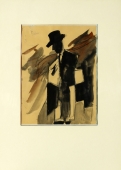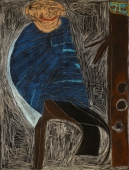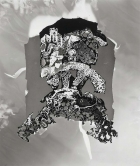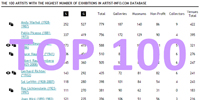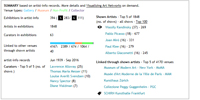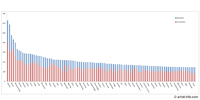
Artist | Cecilia Edefalk (*1954)
https://www.artist-info.com/artist/Cecilia-Edefalk
Biography
Biography
born in 1954 in Norrköping (Sweden)
lives and works in Stockholm and Berlin
About the work (english / deutsch)
About the work (english / deutsch)
Self-Portraits
The self-portraits, with very different titles, were created in 1993 / 94. They are combined in individual groups. All these works are oil paintings on canvas. All are based on a photograph taken in three-quarter profile. The photo served as model only for the first painting. This first painting then served as the model for the second, the second for the third, and so on. One painting is so thoroughly grey-in-grey that it is virtually unrecognisable. Another has been painted upside down (and looks as though it had simply been hung upside-down as an afterthought).
Cecilia Edefalk paints herself today, on the basis of a photo in which she appears to be younger. Does she remember backwards or forwards? Soren Kierkegaard was tantalised by this question. He addressed it in his wonderful and still highly topical text Repetition (1843), asserting that repetition and memory constitute the same movement, albeit in different directions; that what is remembered has been and is repeated backwards, while actual repetition is an act of remembering forwards. Appearing to be younger in the paintings has nothing whatsoever to do with a wish to look younger. The point is that the paintings (the photograph is unknown) do not capture a moment in time, but a period of time of fluctuating dimension, within which past, present and future extend. Cecilia Edefalk remembers forwards because she links the way she feels now with her memory, without falling prey to it. Hers is the resonance of a biographical body to which she listens now. The shadows cast by this listening alter the expression.
Selbstbildnisse
Die Selbstbildnisse, die ganz verschiedene Titel haben, sind 1993 / 94 entstanden. Sie sind in einzelne Werkgruppen zusammengefaßt. Es handelt sich durchgehend um Gemälde, entstanden in Öl auf Leinwand. Ausgangssituation bildet eine Fotografie in Dreiviertelansicht. Die Fotografie dient nur dem ersten Bild als Vorlage. Dieses erste Bild bildet dann die Vorlage für. das zweite, das zweite die Vorlage für das dritte usw. Einmal ist das Bildnis grau in grau gemalt, so daß es fast nicht mehr erkennbar ist. Und einmal malt die Künstlerin das Bild auf dem Kopf. (Es sieht so aus, als wäre es nachträglich auf den Kopf gestellt worden.)
Cecilia Edefalk malt sich heute, ausgehend von einer Fotografie von heute, in der sie, gemäß den Bildern, jünger erscheint. Erinnert sie sich zurück oder nach vorne? Die Frage beschäftigte Sören Kierkegaard in seinem wunderbaren und hochaktuellen Text Die Wiederholung (1843). "Wiederholung und Erinnerung", so schreibt er, "sind dieselbe Bewegung, nur in entgegengesetzter Richtung. Denn was da erinnert wird, ist gewesen, wird nach rückwärts wiederholt, wohingegen die eigentliche Wiederholung nach vorwärts erinnert." Das Jünger-Erscheinen in den Bildern hat überhaupt nichts zu tun mit einem Jünger-Aussehen-Wollen. Vielmehr ist es so, daß die Bilder - die Fotografie ist unbekannt - nicht einen Zeitpunkt, sondern einen Zeitraum von fluktuierender Größe festhalten, in welchem sich Vergangenheit, Gegenwart und Zukunft ausdehnen.
The Circle
Following the group of four paintings In the Painting the Painting, in 1996 she painted a circular picture which she entitled The Circle. And connected with the lauer, she created some watercolors, which, like the oil painting, depict an elephant man, the Ganesá of Indian mythology. The son of Shiva and Párvatí is considered the God of wisdom and the God who removes all obstacles; it is he who grants success in the worldly as well as the spiritual dimension.
The oil painting as well as the watercolors are painted in gray. Cecilia Edefalk reinterprets Ganesá. In the watercolors he bears the weight of his heavy trunk, the end of which resembles the head of penis, on his hand; in the oil painting, by contrast, the trunk hangs down parallel to his arm. T'he circular segment cuts through both his hands and the end of his trunk. It is a strange painting, for the elephant man, with his huge dark eyes, appears to have been frozen, frightened of himself, like Sisyphus, captured in a moment of helplessness given the heavy burden fate has placed upon him. - T'he trunk (= penis?) becomes a weight. The weight of time. - The tantric principle overcomes pleasure and the burden of life. Cecilia Edefalk sublates these through her painting.
The Circle
Im Anschluß an die Vierergruppe In the Painting the Painting entstand ein kreisrundes Bild, das sie mit The Circle (1996) bezeichnet. Damit in Zusammenhang, schuf sie einige Aquarelle, die wie das Bild in Öl einen Elephantenmenschen zeigen, in der indischen Mythologie Ganesha genannt. Der Sohn Shivas und Párvatís gilt als Gott der Weisheit und Beseitiger aller Hindernisse; er gewährt im weltlichen wie auch im spirituellen Leben Erfolg.
Das Ölbild wie auch die Aquarelle sind in grau gemalt. Cecilia Edefalk deutet Ganesha um. Während er in den Aquarellen das Gewicht des schweren Rüssels, dessen Ende einem Peniskopf gleicht, auf der einen Hand abstützt, hängt der Rüssel im Ölbild parallel zu den Armen herab. Das Kreissegment beschneidet sowohl die Hände als auch das Ende des Rüssels. Es ist ein merkwürdiges Gemälde, denn der Elephantenmensch, mit großen dunklen Augen, erscheint wie erstarrt, erschrickt vor sich selbst, einem Sysiphos gleich, der ob der schicksalsbedingten Bürde in einen Moment der Hilflosigkeit verfällt. - Der Rüssel (= Penis?) wird zum Gewicht. Zum Gewicht von Zeit. - Das tantrische Prinzip hebt Lust und Bürde auf. Cecilia Edefalk hebt diese durch die Malerei auf.
German text by Jean-Christophe Ammann / Translation by Ishbel Flett
(Extract - Full printed version available in the Museum)
MMK - Museum für Moderne Kunst, Frankfurt am Main
 offers / Requests offers / Requests  |
About this service |
|---|
 Exhibition Announcements Exhibition Announcements  |
About this service |
|---|
 Visualization |
Learn more about this service | ||
|---|---|---|---|

Interested in discovering more of this artist's networks?
3 easy steps: Register, buy a package for a visualization, select the artist.
See examples how visualization looks like for an artist, a curator, or an exhibition place: Gallery, museum, non-profit place, or collector.

Exhibition History

|
SUMMARY based on artist-info records. More details and Visualizing Art Networks on demand. Venue types: Gallery / Museum / Non-Profit / Collector |
||||||||||||
| Exhibitions in artist-info | 41 (S 10/ G 31) |
Did show together with - Top 5 of 580 artists (no. of shows) - all shows - Top 100
|
||||||||||
| Exhibitions by type | 41: 8 / 18 / 14 / 1 | |||||||||||
| Venues by type | 31: 7 / 9 / 14 / 1 | |||||||||||
| Curators | 17 | |||||||||||
| artist-info records | Mar 1993 - Sep 2022 | |||||||||||
|
Countries - Top 5 of 10 Germany (15) Sweden (11) Italy (3) United States (3) United Kingdom (2) |
Cities - Top 5 of 25 Frankfurt am Main (8) Stockholm (6) Skärhamn (3) New York (2) Venezia (2) |
Venues (no. of shows )
Top 5 of 31
|
||||||||||
Curators (no. of shows)
Top 5 of 17
|
| Kestner-Gesellschaft | G | Jun 2022 - Sep 2022 | Hannover | (580) | +0 | |
| Wilmschen, Alexander (Curator) | +0 | |||||
| Budak, Adam (Curator) | +0 | |||||
| Aargauer Kunsthaus | G | Sep 2019 - Jan 2020 | Aarau | (103) | +2 | |
| Schuppli, Madeleine (Curator) | +0 | |||||
| MATRIX - BAM/PFA | S | Jun 2016 - Oct 2016 | Berkeley | (275) | +0 | |
| DiQuinzio, Apsara (Curator) | +0 | |||||
| Nordiska Akvarellmuseet | G | Mar 2016 - Sep 2016 | Skärhamn | (75) | +0 | |
| Nordiska Akvarellmuseet | G | May 2015 - Sep 2015 | Skärhamn | (75) | +0 | |
| GALLERI F15 | G | Jan 2015 - Mar 2015 | Moss - Jeløy | (9) | +0 | |
| Nilsson, John Peter (Curator) | +0 | |||||
| Sandqvist, Gertrud (Curator) | +0 | |||||
| Keep reading |
















